Blogs

Understanding Chrome Nickel Alloys: An In-Depth Tutorial on Properties and Applications
Introduction
The versatility of chrome nickel alloys positions them as critical materials across various industries, from aerospace to automotive. Characterized by their high strength, excellent ductility, and remarkable corrosion resistance, these alloys are engineered to meet the demanding requirements of modern applications.
As procurement managers navigate the complexities of material selection, understanding the fundamental properties and manufacturing techniques of chrome nickel alloys becomes essential. This knowledge not only aids in optimizing performance but also ensures compliance with industry standards.
Furthermore, the challenges associated with their use, such as sulfide corrosion and cost considerations, highlight the need for strategic decision-making in procurement processes.
This article delves into the multifaceted applications, inherent properties, and critical manufacturing methods of chrome nickel alloys, providing valuable insights for professionals aiming to leverage these materials in their operations.
Fundamental Properties of Chrome Nickel Alloys
Chrome chromium mixtures, primarily consisting of chromium and other metals, are characterized by a range of exceptional attributes that make them essential in various uses. Key characteristics include:
- High Strength: These alloys exhibit exceptional strength retention at elevated temperatures, making them ideal for use in high-stress environments typical of aerospace and nuclear applications. Notably, Alloy 600M, with a niobium addition, was specifically developed to enhance stress corrosion cracking (SCC) resistance in boiling water reactors (BWRs).
- Excellent Ductility: Chrome chrome-based materials are recognized for their ability to be easily formed and fabricated without compromising structural integrity, which is crucial in manufacturing processes that require intricate shapes and designs.
- Thermal Stability: The materials exhibit commendable thermal conductivity, enabling efficient heat dissipation, crucial in uses like heat exchangers that require dependable thermal management.
- Oxidation Resistance: The chromium content forms a protective oxide layer, significantly enhancing oxidation resistance and extending the lifespan of components exposed to harsh environments.
Alongside chrome nickel alloys, Domadia’s Mica Tape products demonstrate high-temperature resistance and outstanding electrical insulation, rendering them perfect for essential uses across diverse sectors. Mica insulation tape guarantees reliability and durability in both household appliances and industrial machinery, while specialized mica tapes, intended for use in fire-resistant cables and other critical electrical insulation systems, provide essential flame resistance and dielectric strength. Recent advancements in nickel-based materials, including the electrodeposition techniques used in aerospace, further underscore their exceptional properties and adaptability.
Comprehending these characteristics, including the ribbon thickness for the material ranging from 0.2 mm to 0.5 mm, is essential for choosing the suitable metal for particular uses while ensuring adherence to industry standards. As Toshio Yonezawa notes, “Nickel-Based Alloys are essential in various fields due to their unique properties and adaptability.” This insight emphasizes the significance of both chrome and Mica tape products in contemporary engineering applications.
Furthermore, at Domadia, we emphasize quality; each product undergoes thorough testing and inspection processes, ensuring that our copper materials meet the highest industry standards for performance and reliability.
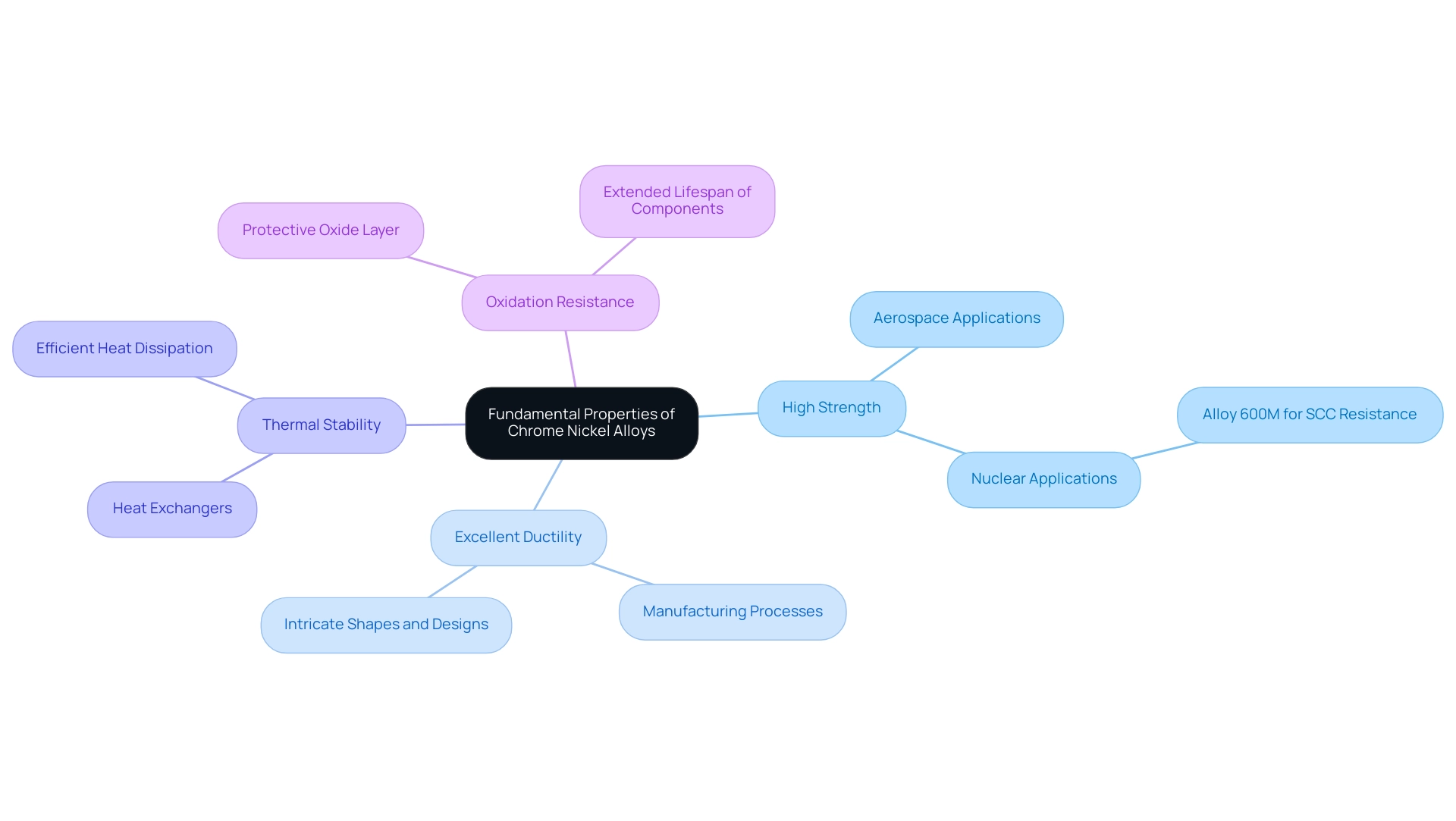
Applications of Chrome Nickel Alloys in Various Industries
Chrome nickel alloys are fundamental to a multitude of industries, due to their unique properties that enhance performance. Important uses encompass:
Automotive Sector: These materials are widely utilized in producing parts like exhaust systems and turbocharger housings. The remarkable heat and corrosion resistance of chrome nickel alloys make them ideal for high-performance applications, as highlighted by industry engineers who emphasize their reliability under extreme conditions. Aditi Shivarkar observes that the automotive sector’s dependence on chrome-based materials is indicative of their vital role in attaining efficiency and performance.
Electronics: In this sector, chrome-based materials serve as essential components for connectors and circuit boards where reliability and conductivity are crucial. The demand for durable electronic components continues to rise, positioning these materials as a preferred option among manufacturers. Businesses are investing significantly in research and development to improve metal properties, which further facilitates their use in this sector.
Aerospace: Chrome chromium mixtures play a crucial role in aerospace applications, particularly in engine parts and structural components that require lightweight yet strong materials. The latest trends indicate a significant shift towards these materials, driven by the industry’s pursuit of efficiency and performance. Significantly, Asia Pacific possessed the largest market share of 43% in the global nickel-based materials market in 2023, highlighting the region’s significance in this sector.
Medical Devices: In the medical field, these materials are utilized in surgical instruments and implants, valued for their biocompatibility and durability. This guarantees that they satisfy strict safety criteria while offering durability in essential uses.
The diverse uses of chrome nickel alloys highlight their importance in improving operational efficiency in challenging settings. Notable companies such as VDM Metals, Haynes International, Inc., and Allegheny Technologies Incorporated (ATI) are at the forefront of innovation in this field, demonstrating a strong dedication to quality and progress in material properties.
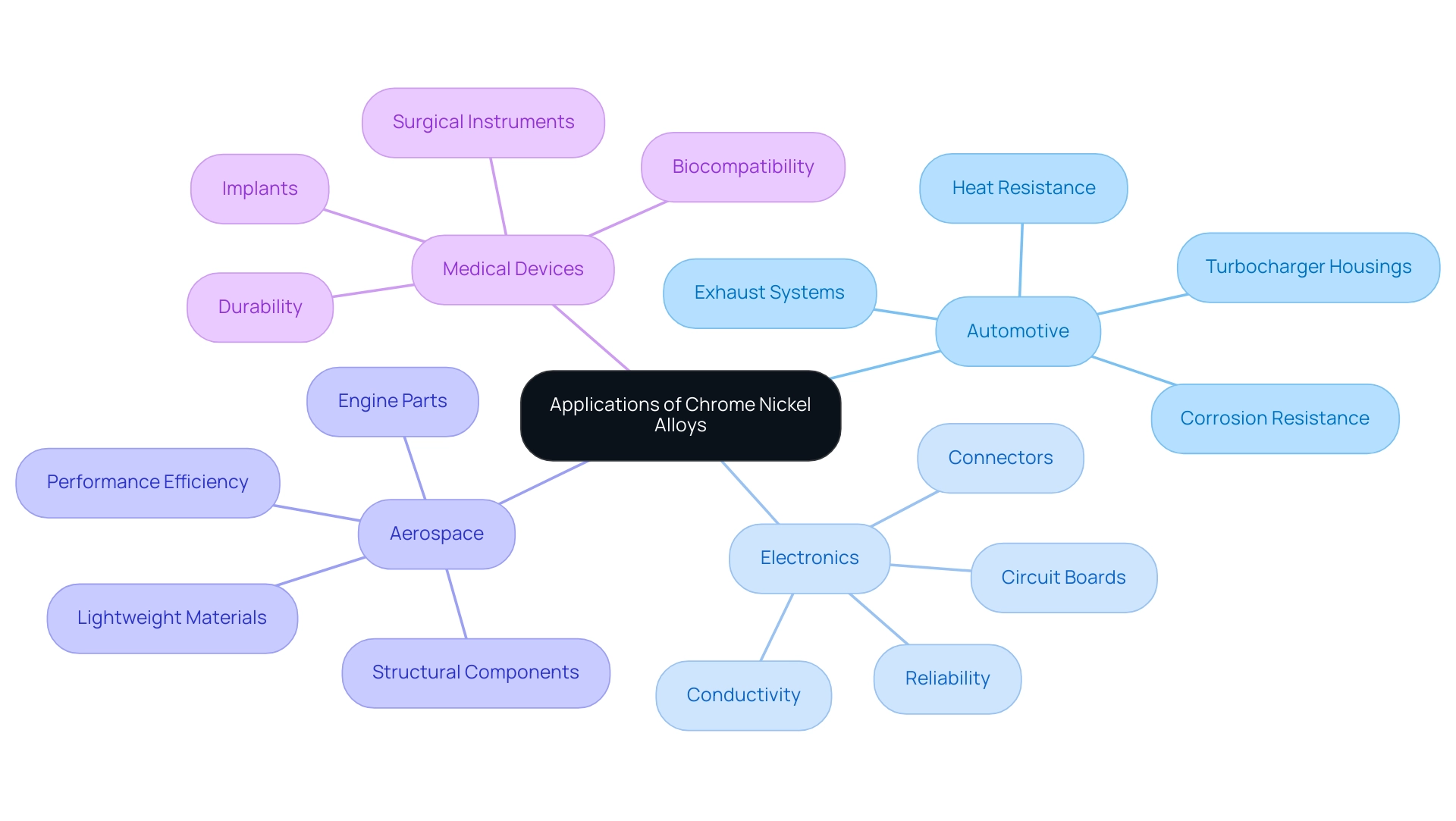
Corrosion Resistance and Durability of Chrome Nickel Alloys
Copper metal mixtures are acknowledged for their remarkable benefits, especially in marine settings and electrical uses. Key characteristics of these materials include:
Corrosion Resistance: Copper and nickel-based materials exhibit high resistance to corrosion, especially in marine environments, making them ideal for applications in shipbuilding and offshore structures.
Thermal and Electrical Conductivity: Chrome nickel alloys provide excellent thermal and electrical conductivity, which is crucial for various industrial applications such as heat exchangers and electrical connectors.
Ductility and Ease of Fabrication: Chrome nickel alloys are known for their good ductility, allowing for easy shaping and fabrication, which is advantageous in manufacturing processes.
Antimicrobial Properties: The inherent antimicrobial properties of copper and nickel-based materials make them suitable for applications requiring high hygiene standards, such as in healthcare and food processing industries.
Understanding these attributes is essential for procurement managers to select materials that ensure reliability and cost-effectiveness in demanding environments.
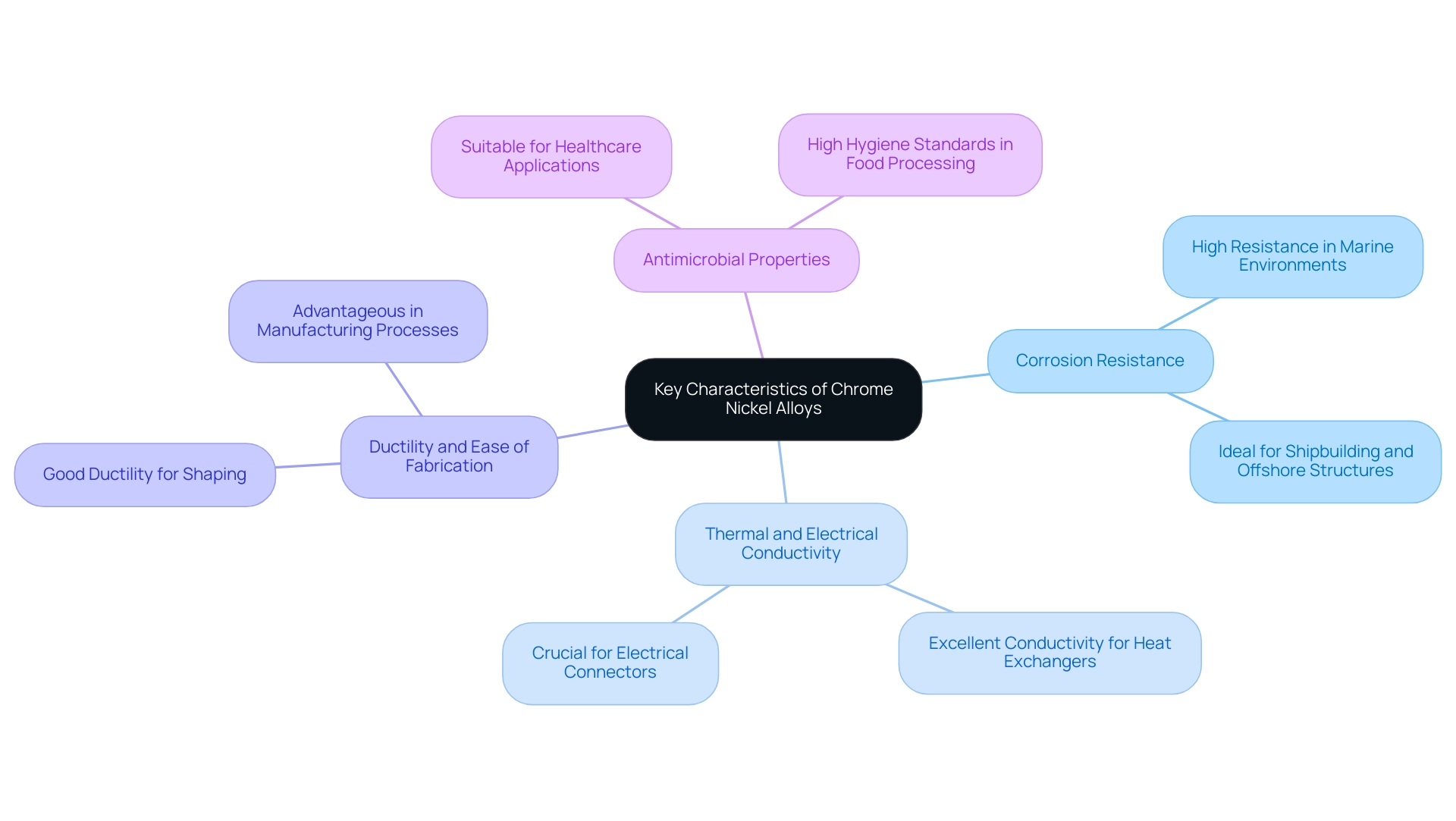
Manufacturing Techniques for Chrome Nickel Alloys
The production of chrome nickel alloys involves a variety of methods that greatly affect their ultimate characteristics and functionality. Key methods employed in this process include:
Casting: This technique is particularly advantageous for producing complex shapes with high precision and minimal waste. The latest trends in casting emphasize innovations that enhance efficiency and reduce environmental impact, aligning with the growing demand for sustainable manufacturing practices.
Forging: Forging plays a critical role in enhancing the strength and durability of certain metal mixtures. By refining the grain structure, this method enhances mechanical properties, producing materials that can endure challenging uses. The advantages of forging extend to better fatigue resistance and overall performance, making it a preferred choice in various industries.
Machining: Essential for achieving specific dimensions and surface finishes, machining is a vital step in the production of specialized metal mixtures. This process enables manufacturers to customize the materials to meet stringent application requirements, ensuring optimal performance in their respective fields.
Moreover, recent statistics indicate that the deposition efficiency of EHLMD is 5–10 times higher than that of conventional LMD, highlighting the advancements in manufacturing techniques that can significantly enhance productivity and material quality.
As noted by a Global Consulting Firm, “Our company has been working with [the manufacturer] for some years now and we are very happy with the quality of the reports provided by the company.” This endorsement highlights the significance of quality insights in the manufacturing process of stainless steel materials.
Additionally, JLC Electromet Pvt. Ltd. distinguishes itself as a prominent producer of specialty materials based on nickel, certified with ISO:9001, and supplying to more than 50 nations. Their commitment to excellence exemplifies the standards expected in this industry.
Selecting the appropriate manufacturing method can profoundly impact the characteristics of chrome nickel alloys, influencing essential factors such as corrosion resistance, tensile strength, and wear resistance. As industries increasingly prioritize high-quality materials, understanding these techniques and their implications becomes crucial for procurement managers aiming to make informed decisions.
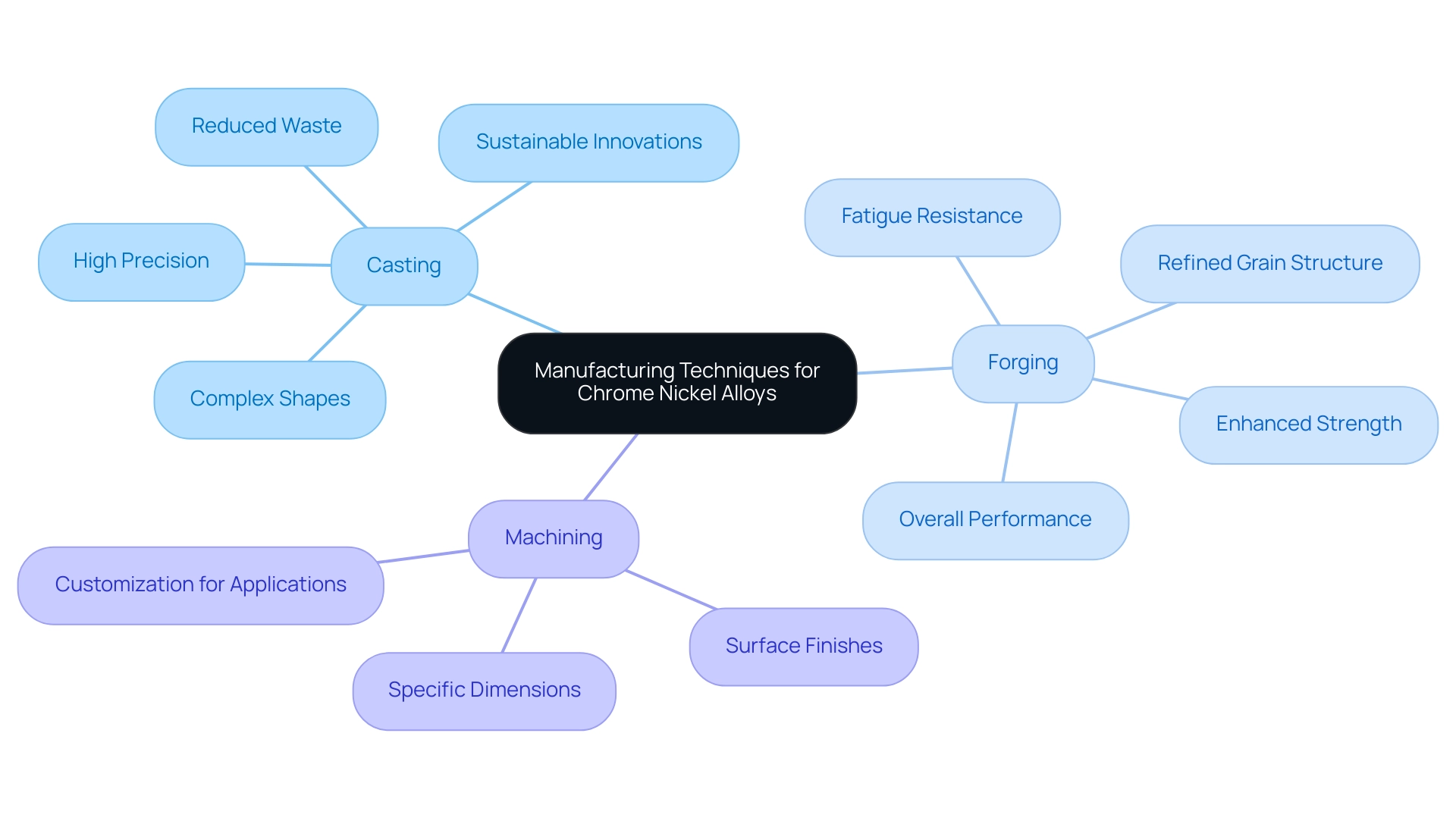
Challenges and Considerations in the Use of Chrome Nickel Alloys
While chrome nickel alloys present significant advantages, there are several challenges that procurement managers must navigate:
Sulfide Corrosion: These alloys can be vulnerable to sulfide stress cracking, particularly in environments with high sulfide concentrations. This vulnerability can result in early failure, highlighting the significance of comprehending the particular conditions under which these materials function. Recent reports suggest that sulfide corrosion rates in stainless steel materials can differ markedly depending on environmental factors, highlighting the necessity for careful monitoring and evaluation. Significantly, corrosion rates for nickel-based materials in atmospheric conditions are generally below 0.0025 mm/yr, offering a quantitative foundation for assessing their performance in different environments.
Cost Considerations: High-performance materials such as chromium may involve a significant expenditure. Procurement managers should conduct a thorough cost analysis against alternative materials, taking into account both initial purchase prices and long-term performance benefits. This strategic approach ensures that the selected materials align not only with project budgets but also with performance expectations.
Compatibility Issues: Ensuring compatibility with other materials within assemblies is essential to prevent galvanic corrosion. Careful selection and testing of materials are necessary to mitigate risks associated with dissimilar metals in contact. This is especially pertinent in complex systems where chrome steel mixtures are integrated with other metals, as any lack of compatibility could lead to increased maintenance costs and reduced service life.
A case study titled “Water Corrosion Resistance” emphasizes that nickel-containing materials and nickel-based compositions demonstrate outstanding corrosion resistance in distilled water and freshwater, with extremely low corrosion rates. Nickel 200 and nickel-copper combinations are effectively utilized in freshwater systems because of their low corrosion rates, highlighting the significance of choosing the appropriate materials for particular uses. As M. Beckwith, Chairman, noted, “If there are no further questions, thank you, Mr. Safranek,” emphasizing the need for clarity and thorough understanding in procurement decisions.
By being cognizant of these challenges, procurement managers can devise effective strategies to mitigate risks and optimize the use of chrome nickel alloys in their projects.
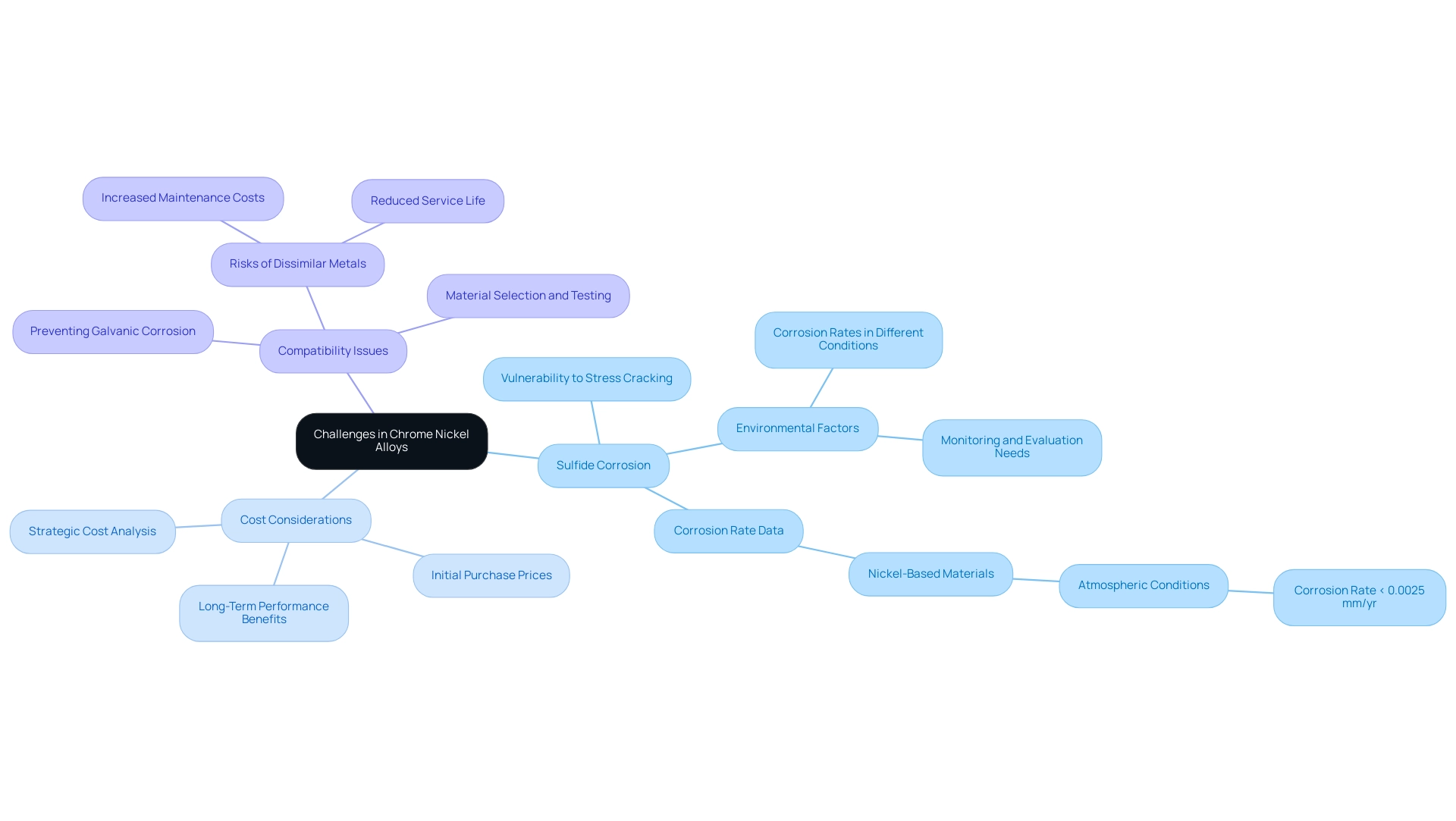
Conclusion
The exploration of chrome nickel alloys reveals their indispensable role across various industries, underscoring their unique properties, applications, and the intricacies of their manufacturing processes. With characteristics such as high strength, excellent ductility, and formidable corrosion resistance, these alloys are tailored to meet the rigorous demands of sectors ranging from aerospace to automotive and medical devices. Their ability to perform under extreme conditions not only enhances operational efficiency but also ensures compliance with industry standards.
However, procurement managers must remain vigilant regarding the challenges associated with these alloys. Issues like sulfide corrosion and cost considerations necessitate strategic decision-making to ensure that the selected materials not only fit within budget constraints but also deliver long-term performance benefits. Moreover, understanding the manufacturing techniques—such as casting, forging, and machining—can significantly influence the properties of chrome nickel alloys, making it crucial for professionals to choose the right method for their specific applications.
In conclusion, the knowledge of chrome nickel alloys is vital for optimizing material selection and enhancing operational performance. By navigating the complexities of their properties, applications, and potential challenges, procurement managers can make informed decisions that leverage the full potential of these versatile materials, ultimately driving success in their projects and industries.




